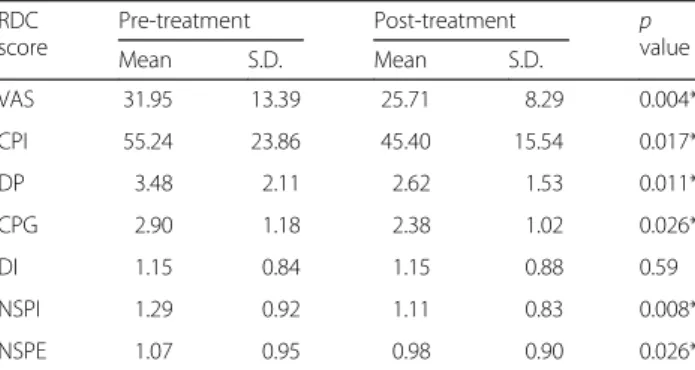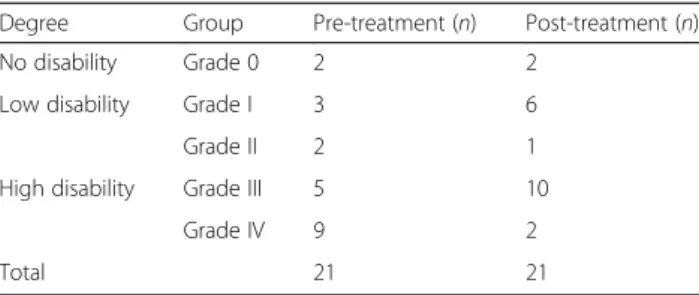R E S E A R C H Open Access
A clinical evaluation of botulinum toxin-A injections in the temporomandibular
disorder treatment
Hyun-Suk Kim 1 , Pil-Young Yun 1 and Young-Kyun Kim 1,2*
Abstract
Background: This study clinically evaluated the effect of botulinum toxin type A (BTX-A) in the temporomandibular disorder (TMD) treatment using Research Diagnostic Criteria for Temporomandibular Disorders (RDC/TMD).
Methods: A total of 21 TMD patients were recruited to be treated with BTX-A injections on the bilateral masseter and temporalis muscles and were followed up by an oral and maxillofacial surgeon highly experienced in the TMD treatment. For each patient, diagnostic data gathering were conducted according to the RDC/TMD. Characteristic pain intensity, disability points, chronic pain grade, depression index, and grade of nonspecific physical symptoms were evaluated. Wilcoxon signed-rank test was applied for statistical analysis.
Results: The results showed that more than half of the participants (85.7 %) had parafunctional oral habits such as bruxism or clenching. In comparison between pre- and post-treatment results, graded pain score, characteristic pain intensity, disability points, chronic pain grade, and grade of nonspecific physical symptoms showed statistically significant differences after the BTX-A injection therapy ( p < 0.05). Most patients experienced collective decrease in clinical manifestations of TMD including pain relief and improved masticatory functions after the treatment.
Conclusions: Within the limitation of our study, BTX-A injections in masticatory musculatures of TMD patients could be considered as a useful option for controlling complex TMD and helping its associated symptoms.
Keywords: Botulinum toxin type A, Temporomandibular disorder, Research diagnostic criteria for temporomandibular disorder
Background
Temporomandibular disorders (TMD), musculoskeletal disorders of the masticatory system, are common clinical labels for pain in the orofacial area. Causes of TMD symp- toms are often complex and idiopathic, and problems involve extra-articular and intra-articular pathologic condi- tions or a combination of the both. TMD patients manifest various symptoms including myofascial tenderness and pain, headache, joint noises, trismus, and even tinnitus. In symptomatic muscle areas, a number of trigger points could be present, and palpating these musculatures gener- ally initiates radiating discomforts along with cascading
pains on multiple muscle and neuronal tracks. Depending on contributing factors, these symptoms may be transient or perpetuating [1].
Successful TMD treatment starts from correctly differ- entiating the origin of symptoms. Since myofascial pains and mouth opening limitation are the most frequent symptoms in masticatory muscle disorders, directing treatments at the muscular components of TMD could yield therapeutic gains. Therefore, noninvasive conserva- tive treatments such as counseling, soft diet, behavior medicine, physiotherapy, oral appliances, pharmacother- apy, and botulinum toxin injections are reported to be effective as first-line therapies for extra-articular patho- logic conditions [2].
Intra-articular pathologic conditions such as internal derangement and osteoarthritis could also benefit from the reversible interventions used to treat myofascial pains.
* Correspondence: kyk0505@snubh.org
1
Department of Oral and Maxillofacial Surgery, Section of Dentistry, Seoul National University Bundang Hospital, 300 Gumi-dong, Bundang-gu, Seongnam, Gyunggi-do, South Korea
2


